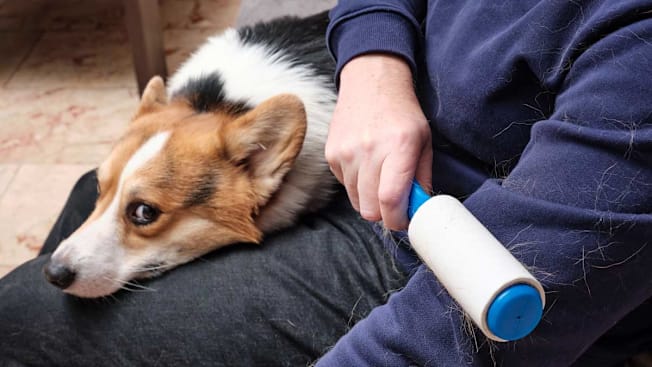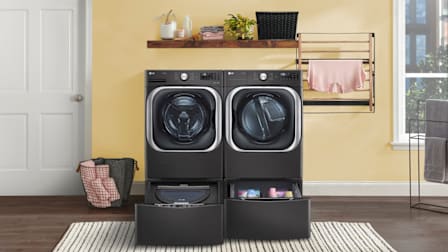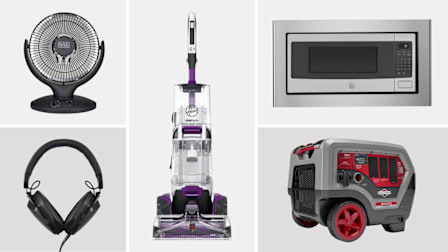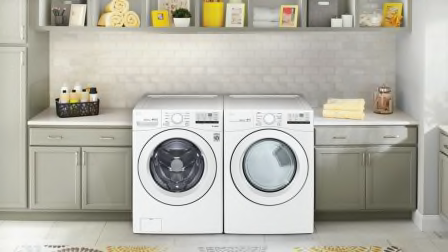Don't Let Pet Hair Ruin Your Washer
For starters, try to keep all that fur out of the machine
When you shop through retailer links on our site, we may earn affiliate commissions. 100% of the fees we collect are used to support our nonprofit mission. Learn more.

You love your pets unconditionally. Why else would you tolerate their shedding all over your bed, carpets, blankets, and clothes?
If your pet sheds, you probably do a lot of laundry—especially if your little pal is a double-coated breed like a shepherd, husky, or retriever; or a fluffy feline like a Maine coon or Persian. Removing pet hair is a complicated chore—for you and your washing machine.
“Pet hair is definitely a challenge to remove from most fabrics,” says Randy Radtke, a spokesperson for laundry appliance maker Speed Queen. “Once water is added to the equation, it becomes that much more difficult.” The mix of water and pet hair results in clumps that stick to fabrics and the sides of the washer drum, clogging drain pumps.
Your Guide to the Best Pet Products
Your Bed
Put on a rubber glove, dampen it with water, and run your hand over the sheet or blanket. The hair will cling to the glove, making it easier to gather and discard.
When you’ve removed as much hair as possible, follow these steps.
• Before washing, run clothes or beddingthrough a 10-minute, no-heat dryer cycle (typically called “air fluff”). This will loosen the pet hair, which winds up in the lint trap. Throw in a dryer sheet, because any static buildup can keep hair bonded to fabric. Take the items out of the dryer, give them a good shake to remove any remaining pet hair, and then toss them in the washer. Be sure to clean your dryer’s lint filter after every load, and clean the dryer duct annually (or more often if you notice your dryer is taking longer, which might happen if you regularly put your dog’s bed in the dryer).
• Add a half cup of distilled white vinegar to the machine’s rinse cycle. Vinegar is a natural fabric softener that helps loosen pet hair. But be sure to check your owner’s manual first because repeated vinegar use can damage your washing machine, and some brands, including Whirlpool, caution against using it at all.
• Clean your washer by running a wash cycle or self-clean cycle without laundry. After the cycle ends, wipe down your machine’s drum, door, and gasket with a damp cloth. “This will help remove any residual pet hair from the machine and reduce the likelihood of it transferring to your next load of laundry,” says Rich Handel, CR’s laundry expert.
Need a new washer? See our comprehensive washing machine ratings.
Your Pet's Bed
Here’s what the American Cleaning Institute recommends for cleaning a pet’s bed.
• Use a vacuum, a lint brush, or sticky tape to remove as much fur as possible from your pet’s bed, paying special attention to corners and around any buttons or tufting.
• If possible, remove the bed cover and use a stain remover on any extra dirty or funky spots.
• Check the label for washing instructions, then load the cover or the entire bed in the washer (if it doesn’t fit, the bathtub will do). Washing in hot water can help kill any insects and eggs that may be on the bed. (In most cases, a washer’s extra rinse cycle does the best job of rinsing away stubborn pet hair.)
• If it fits, dry the bed in your dryer. A dryer sheet helps reduce static and remove any remaining hair. Clean the dryer’s lint filter halfway through the cycle because the cleaner it is, the more hair the filter can catch. If you put the bed out to dry, place it in a well-ventilated area to help prevent mildew and mold.
• Afterward, wipe the washer’s drum with a damp paper towel to remove any hair.
• If you still see a lot of hair in your pet’s bed, allow the bed to air-dry, then use the soft attachment of your vacuum cleaner to remove the remaining hair.
Washers With Pet Hair Removal Cycles
Some washers and dryers have “pet hair” cycles designed to make hair removal easier. These cycles generally boost water pressure, wash time, or airflow to loosen pet hair from fabrics.
Optional cycles are not typically evaluated in CR’s performance testing. But we did evaluate the Maytag MFW7020RF top-loader (one of two Maytag Pet Pro machines) for both general performance and pet hair removal using the Pet Pro cycle.
Our formal testing found the washer to be excellent at cleaning clothes in general. For our informal hair removal evaluation, we used Maine coon cat hair (the same type from our vacuum tests) and the machine’s Pet Pro cycle, which is designed to catch pet hair in a baffle inside the drum.
Results may vary based on the type of hair your pet has, but we found that this washer’s Pet Pro cycle didn’t remove hair any better than not using it, although we did see an increase in the cycle time and the amount of water used. In fact, in our comparative evaluation, an older front-load washer removed more hair.
The machines below (including a front-loader, a top-loader, and an all-in-one washer/dryer) feature cycles designed to remove pet hair. They’re listed in order of Overall Score in our standard washing performance tests, based on the machine’s most aggressive normal cycle.
@consumerreports Pet parents, does pet hair seem to follow you everywhere? We understand the feeling 😩 At CR, we’re here to help you make sense of marketing claims. Tap the link in our bio to see the best washing machines of the year. #cleantok #cleaningtiktok #laundrytok #pethair
♬ original sound - Consumer Reports
































